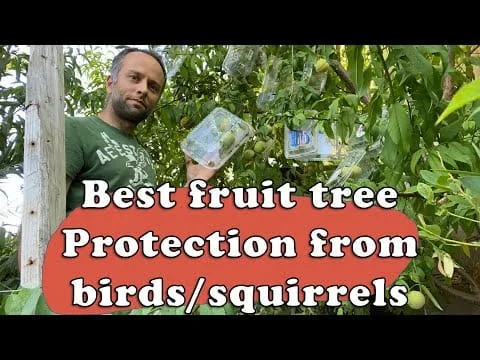Fruit trees are a great addition to any backyard, but they can be vulnerable to pests like squirrels. If you have fruit trees on your property, you’ll need to take steps to protect them from these pesky critters. This article will provide some tips on how to protect your fruit trees from squirrels and keep them healthy and productive.The primary problems with squirrels eating fruit trees are that the squirrels can damage the trees, eat or destroy the fruit, and spread disease. Squirrels may strip bark from trees, which can weaken or kill the tree. They can also eat flowers, leaves, buds, and fruits before they have a chance to ripen. This can reduce yields and cause economic losses for farmers and other fruit tree owners. In addition, squirrels may carry diseases that they can spread to fruit trees through their droppings and urination. These diseases can weaken or kill the trees over time.
Identifying The Type Of Squirrels Involved
The identification of the type of squirrels involved in any particular situation is an important step in understanding the behavior and habitat of these animals. There are several different types of squirrels that can be found inhabiting different parts of the world, including flying squirrels, ground squirrels, and tree squirrels. In order to accurately identify which type of squirrel is present in a given area, it is important to take into account several factors such as size, coloration, diet, and habitat.
Size can be used to distinguish between different types of squirrels. Flying squirrels tend to be much smaller than ground or tree dwelling species and have larger eyes and flaps of skin between their legs which they use for gliding through the air. Ground squirrels are usually larger than their arboreal relatives and tend to have shorter tails. Tree dwelling species can range from small to large depending on the specific species involved.
In terms of coloring, flying squirrels generally have grayish-brown fur on their back with white underneath while ground and tree species can vary greatly in coloration from black to red or even white depending on the species involved. Diet can also be used as a distinguishing factor as some species will feed mainly on nuts while others may feed on insects or other sources. Finally, the habitat that each type of squirrel inhabits should also be taken into account when trying to identify which type is present in any given area as some may inhabit trees while others may be found exclusively on the ground or in burrows they have dug themselves.
How To Deter Squirrels From Eating Fruit Trees
Squirrels can be a real nuisance when it comes to eating fruit trees, and it can be difficult to get rid of them. Fortunately, there are several strategies that you can use to deter squirrels from eating your fruit trees.
One of the most effective ways to keep squirrels away from your fruit trees is to use deterrent sprays. These sprays contain chemicals that make the fruit taste bad or unappealing to squirrels, discouraging them from coming back for more. You can purchase these sprays at most garden centers or online.
Another option is to set up physical barriers around the fruit tree. This could include fencing, netting, or even installing a motion-activated sprinkler system that will startle the squirrels when they approach the tree.
You can also try using scare tactics to keep the squirrels away from your fruit trees. Placing shiny objects such as CDs and silver foil near the tree can create an intimidating environment for the squirrels, making them less likely to approach. You could also hang wind chimes or place motion-activated lights in and around the tree.
Finally, you may want to consider using repellents such as predator urine or hot pepper spray near your fruit trees. The smell of these substances will discourage the squirrels from coming back for more of your delicious fruit!
Overall, there are several strategies you can use to deter squirrels from eating your fruit trees. With a little bit of effort and patience, you should be able to protect your precious harvest without too much trouble!
Planting Unpalatable Ornamental Plants Around Fruit Trees
Fruit trees are a great way to add beauty and freshness to your garden or yard. However, with the arrival of unwanted pests, it is important to find ways to protect your trees from harm. One way to ensure the safety of your fruit trees is by planting unpalatable ornamental plants around them. These plants can help deter pests while adding a touch of color and texture to your garden.
When choosing an ornamental plant, make sure it is not attractive to the pests that commonly attack fruit trees. For example, if you have a problem with aphids or other sap-sucking insects in the area, avoid planting flowers with sweet nectar or brightly colored petals as they will attract these pests. Instead, look for plants that naturally repel pests such as marigolds or lavender.
In addition, unpalatable plants can also act as a physical barrier between the tree and potential pests. For example, if you have deer in your area then a hedge of holly or prickly shrubbery can help keep them away from your fruit tree. Similarly, if you’re worried about birds and rodents in the area then adding a layer of spiny foliage around the tree can provide an effective barrier against these animals.
Finally, don’t forget that ornamental plants can also add visual appeal to your garden or yard. While some may choose to plant only functional plants around their fruit trees, others may want to add some color and texture with decorative foliage or flowers as well. Whether you prefer tall grasses or colorful blooms, there are plenty of options when it comes to selecting ornamental plants for around your fruit trees.
Overall, planting unpalatable ornamental plants around fruit trees is an effective way to protect them from harm while adding visual appeal at the same time. So don’t be afraid to mix functional and decorative elements when planning out your garden!
Installing A Fence Around Fruit Trees
Fences are a great way to protect your fruit trees from animals that may want to eat your fruits or harm the trees themselves. By installing a fence around fruit trees, you can keep animals away and also keep your tree safe from damage caused by wind or heavy rain. Installing a fence is easy and can be done in just a few steps.
The first step in installing a fence around your fruit tree is to determine the size of the fence that you need. Measure the circumference of the tree and then add about two feet on each side to make sure that you have enough space for the fence posts and gate. Once you have determined the size of the fence, you will need to purchase the materials necessary for installation.
Next, mark out where you will be placing each post for your fence. Make sure that each post is firmly secured in the ground and level with one another so that your fence does not lean or bend when it is finished. You can use metal stakes or wooden posts for this purpose depending on what type of material you chose for your fence.
Once all of your posts are in place, start putting up the fencing material around them. It is important to make sure that all sections of fencing are securely attached so that animals cannot get through any gaps or bends in it. Make sure to use nails or screws when attaching fencing material so that it stays in place longer and does not come apart over time due to weathering or other factors.
Finally, add a gate if necessary for easy access into the area surrounding your fruit tree. This will allow you to easily tend to your tree without having to climb over or go through any fencing barriers every time you need access. Once everything is in place, enjoy watching birds and other wildlife while keeping them out of your precious fruit trees!

Applying Repellents On The Fruits And Bark Of Trees
One of the best ways to protect trees from unwanted pests and animals is to apply repellents on the fruits and bark of trees. Repellents are chemical sprays or granules that are applied to the bark and fruits of a tree to repel or deter animals from coming into contact with it. They contain active ingredients such as peppermint oil, citronella, garlic, and other natural oils that work by creating an unpleasant scent that animals find unpleasant. The repellent will also create a barrier between the tree and the animal, preventing them from eating or damaging the tree. Repellents are also effective in keeping away pests such as aphids, ants, beetles, mites and other insects.
In order to apply repellents on the fruits and bark of trees, it is best to use a garden sprayer or an atomizer sprayer. It is important to make sure that the repellent is applied evenly over the entire surface of the tree. It is also important to follow the instructions on the package for proper application as different products have different instructions for application. After applying the repellent, it may be necessary to reapply after a few weeks or months depending on how often pests return to your trees.
It is important to remember that repellents should only be used when necessary in order to protect trees from damage caused by pests or animals. When using repellents, it is important to take safety precautions such as wearing protective eyewear and gloves in order to avoid any potential health risks associated with exposure. Additionally, it is also important not to exceed recommended application rates as this can cause damaging effects on plants and wildlife in your area.
Installing A Bird Feeder Near Fruit Trees
Attracting birds to your garden can be a great way to enjoy nature. Installing a bird feeder near fruit trees is an excellent way to attract birds and help support your local wildlife. Birds are an important part of the food chain, so providing them with a steady source of food is essential for their survival. By installing a bird feeder near your fruit trees, you can provide birds with easy access to food while also providing them with protection from predators.
When choosing a bird feeder, make sure it is designed specifically for the type of birds you want to attract. Different types of birds prefer different types of food, so choosing the right feeder will ensure that you attract the right kind of birds. Additionally, make sure that the feeder is well-constructed and has drainage holes so that it doesn’t become waterlogged after it rains.
Once you have chosen a suitable bird feeder, position it in an area where your fruit trees are easily accessible. Make sure that there are no branches or other obstacles blocking access to the feeder, as this can prevent birds from getting to their food. Additionally, place the feeder in an area where there is plenty of natural light and shelter from wind and rain. This will provide birds with a safe and comfortable place to eat and rest while they visit your garden.
Finally, keep in mind that installing a bird feeder near your fruit trees will also attract other animals such as squirrels or rabbits which may try to eat the bird’s food too. To prevent this from happening, make sure that you regularly fill up your bird feeders with fresh seed and keep them out of reach of other animals.
Installing a bird feeder near your fruit trees can be an enjoyable and rewarding experience for all involved! Not only will you be helping local wildlife but you’ll also get the chance to observe these beautiful creatures up close in their natural habitat!
Trimming Branches To Reduce Accessibility Of Fruits
Trimming branches of fruit trees is an important step for ensuring that the fruits produced are not easily accessible to animals or pests. Trimming helps reduce the amount of fruit that can be reached by animals or pests, thus reducing the potential damage they can cause. Additionally, it can make harvesting easier and more efficient.
Trimming branches of fruit trees helps to keep the canopy open, allowing for better air circulation and light penetration. This helps to create a healthier environment for the tree and promote better overall health. Additionally, it can help to reduce disease and pest infestations in the tree by removing potential hiding spots and reducing overcrowding.
Trimming branches also helps to keep the tree from becoming overcrowded with leaves, fruits, and other debris. This ensures that all parts of the tree are receiving adequate sunlight and nutrients, which is essential for its long-term health. Additionally, it can help limit competition between different parts of the tree for resources such as light and water.
When trimming branches of fruit trees, it is important to use sharp pruning shears or saws to ensure clean cuts without damaging the bark or inner wood. It is also important to consider where you are cutting in order to avoid cutting too close to buds or other living parts of the tree which could cause future damage if not properly cared for. Additionally, be sure that any dead or diseased branches are removed completely from the tree as these can spread diseases and pests throughout your entire garden or landscape.
Overall, trimming branches of fruit trees is a necessary step towards keeping them healthy and productive over time. By reducing accessibility of fruits to animals or pests, improving air circulation and light penetration into the canopy, limiting overcrowding in foliage areas, and ensuring all parts are receiving adequate sunlight and nutrients, regular pruning can help ensure that your fruit trees remain healthy for many years to come!

Conclusion
Protecting your fruit trees from squirrels can be a difficult task, but with the right strategies, it can be done. The key is to be persistent and vigilant. You should install barriers such as fences or netting, use repellents, and remove sources of food and shelter that may attract squirrels. You can also use sound and visual deterrents to scare away any squirrels that trespass on your property. With the right approach, you can protect your fruit trees from these pesky rodents.
Remember, it’s important to take steps to prevent an infestation before it happens. If you do have an infestation, contact a wildlife control specialist or a pest removal company as soon as possible for help. These professionals are trained in dealing with all kinds of wildlife-related issues and can provide you with the best advice on how to solve your problem quickly and safely.



